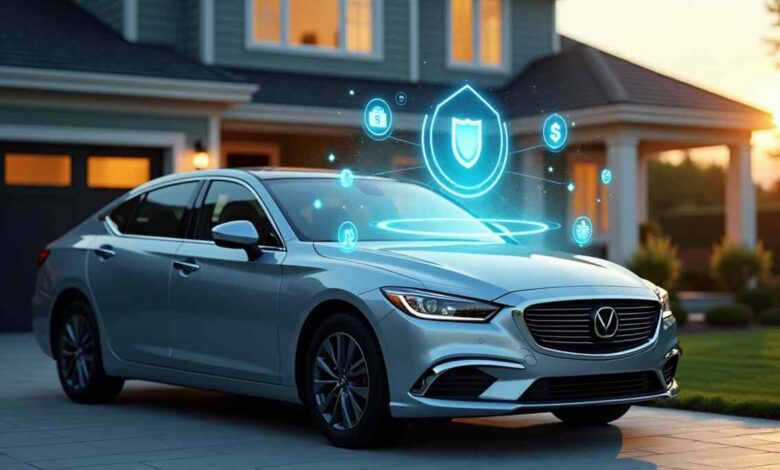Expert Guide to best car insurance (2025) Why You’re Paying Too Much
Best Car Insurance

Best Car Insurance : Did you know that 4 out of 5 Americans are overpaying for their car insurance? My years of watching insurance trends have shown that most drivers could save hundreds of dollars each year by making smarter coverage choices.
Getting great car insurance doesn’t need to break the bank or give you headaches. Let me show you how to pick coverage that works for your needs and wallet. You’ll learn about the hidden factors that change your rates. We’ll uncover pricing secrets and look at the best comparison sites that can help you save money.
This piece covers everything about getting the best car insurance rates in 2024. You’ll learn how new technology and current economic conditions change your premiums. The strategies work well if you’re buying for the first time or just want to switch providers. You’ll find practical ways to stop paying too much for your coverage.
Understanding Today’s Car Insurance Landscape
The auto insurance market has changed dramatically in 2024. The most eye-opening change is the 22% surge in auto insurance rates year-over-year. You need to know how to find the best car insurance in this tough market.
Current market trends and pricing factors
The auto insurance industry faces its biggest shake-up since 1976. Rates have shot up by over 43% in the last few years. Several factors drive these increases:
- Advanced vehicle technology’s repair costs
- Parts shortages from supply chain problems
- More severe accidents
- Higher vehicle theft rates (up 24.9% in recent years)
How technology is changing insurance rates
Technology has changed how insurance companies set their rates. Telematics and AI play a central role in pricing strategies now. This creates new possibilities and hurdles for consumers. Here’s how modern technology affects your premiums:
| Technology Impact | Benefit to Drivers |
|---|---|
| Real-time driving monitoring | Potential discounts for safe driving |
| AI-powered risk assessment | More customized pricing |
| Automated claims processing | Faster claim settlements |
Insurance companies use telematics more often to track driving behavior up-to-the-minute. This helps safe drivers get better rates. Many of my clients save money through usage-based insurance programs.
Impact of 2024 economic conditions
The 2024 economy has created a tricky situation for insurance providers and consumers. Customer retention rates dropped from 83% to 80% as people look for better rates. Insurance companies take bold steps to fix profitability issues. This led to a 14% year-over-year rate increase in 2023.
These changes sparked strong market reactions. New policy purchases grew by 6.2% in 2023. Overall shopping increased by 4.7% that shows more people compare options before deciding.
My research suggests finding affordable coverage is harder now. Smart consumers who know how to work the market can still find good deals. Success comes from understanding how to use these changes when searching for the best car insurance companies.
Hidden Factors Driving Up Your Premium
My research into insurance data revealed something unexpected: your credit score affects your car insurance rates more than your driving record. After analyzing the data, I found several hidden factors that quietly increase your premium costs.
Lesser-known rating factors
Insurance companies use complex algorithms to set their rates. To name just one example, Allstate’s pricing model showed that customers paying around $1,900 per six months saw increases up to 20%, while others only faced 5% increases. Your rates depend on some surprising factors:
- Credit-based insurance scoring (used in most states)
- Prior coverage history and billing experience
- Vehicle technology and data sharing capabilities
Car manufacturers now share your driving data with insurance companies. GM confirmed sharing “select insights” from their Smart Driver program with data brokers. This affects your rates without you even knowing about it.
Industry pricing practices revealed
Insurance companies use complex pricing strategies that most people don’t know about. The “retention model” approach raises some serious concerns. One major insurer’s internal documents showed they created a “suckers list” of customers who would accept the highest increases.
Insurance companies target specific groups:
- Long-term customers who rarely switch
- Drivers who accept rate increases
- Customers with certain demographic profiles
Regional cost variations explained
Your ZIP code plays a huge role in determining your rates. Drivers in lower-income ZIP codes paid $410 more each year than their neighbors in adjacent, higher-income areas.
The differences I found are striking:
| Company | Price Increase Across ZIP Codes |
|---|---|
| Farmers | Up to $734 (31%) |
| Allstate | Up to $661 (28%) |
| GEICO | Up to $315 (30%) |
These variations go beyond accident rates or population density. Insurance companies look at several regional factors:
- Local crime statistics and vehicle theft rates (up 24.9% in 2022)
- Weather-related risks and natural disaster frequency
- Road infrastructure conditions and maintenance patterns
My research shows that these pricing practices lead to different premiums for drivers with similar risk profiles. The differences often stem from socio-economic factors rather than actual driving behavior.
Smart Shopping Strategies for Lower Rates
My years of analyzing insurance trends have shown that drivers can save up to 47% on their premiums by comparing car insurance quotes. Let me share some proven ways to find the best car insurance rates.
Effective comparison shopping techniques
The best advice I give my clients is to get quotes from at least three to five insurance providers. Experience shows that comparing policies with similar coverage limits and deductibles works best. You’ll need these items before starting your search:
- Driver Information:
- License numbers
- Accident history (past 5 years)
- Vehicle details (VIN, mileage)
- Current insurance information
Timing your purchase for best deals
Timing plays a significant role in getting the best deals. You should start shopping three to four weeks before your current policy expires. Some insurers like Liberty Mutual reward early shoppers with special discounts.
All the same, you should shop around right away if you:
- Move to a new state or ZIP code
- Get married
- Purchase a new vehicle
Leveraging online tools and resources
After analyzing many comparison tools, here are the most effective ways to save time and money:
| Comparison Method | Benefits | Considerations |
|---|---|---|
| Direct Insurer Websites | Accurate quotes | Time-consuming |
| Independent Agents | Expert guidance | Limited options |
| Online Comparison Tools | Multiple quotes at once | Potential spam risks |
Independent insurance comparison sites that partner with multiple providers work best. Working with an independent insurance agency can help if you prefer tailored guidance.
A word of caution about popular comparison websites that act as lead aggregators. These sites often sell your information, which leads to unwanted calls and emails. Look for platforms that offer live, side-by-side comparisons from verified insurers instead.
My analysis shows nationwide rates for good drivers range from $144 to $319 monthly between companies. Regular rate comparisons can lead to big savings, especially since insurance companies often adjust their pricing models.
Maximizing Discounts and Savings Opportunities
My analysis of years of insurance data shows most drivers miss out on big savings because they don’t know about all discount opportunities. My experience helping clients get the best car insurance reveals how combining multiple discounts can reduce premiums by up to 40%.
Lesser-known discount programs
Several overlooked discounts exist that many drivers qualify for but rarely claim. To name just one example, some insurers give up to 25% off to engaged couples even before the wedding. Here are other surprising ways to save:
- Advanced degree holders can save 4% on premiums
- Early policy renewal can reduce rates by 2-15%
- Paperless billing and automatic payments can save up to 5%
Combining policies strategically
My career experience shows that bundling insurance policies works best to reduce costs. You can save between 5-25% by combining auto and home insurance right away. Adding boat or motorcycle insurance creates even more savings opportunities.
| Bundle Type | Potential Savings |
|---|---|
| Auto + Home | Up to 25% |
| Auto + Renters | 6-26% |
| Multi-Car | 10-25% |
Usage-based insurance options
Usage-based insurance (UBI) programs are a great way to get savings, especially when you have safe driving habits. These programs use either a mobile app or plug-in device to track driving habits.
My analysis of UBI programs shows that drivers who participate can save an average of $231 annually. The programs typically monitor:
- Driving speed and acceleration patterns
- Braking habits
- Time of day you drive
- Annual mileage
UBI programs paired with other discounts offer immediate savings – some insurers even give an automatic discount just for enrolling. Note that not all drivers will benefit from these programs. Drivers who frequently drive during peak hours or have aggressive driving habits might see their rates increase.
My analysis shows the most successful strategy combines multiple discount opportunities. To name just one example, bundling your policies with enrollment in a UBI program could result in savings of up to 50%.
Optimizing Coverage Without Overpaying
After researching the best car insurance companies, I’ve learned that optimizing coverage isn’t just about finding the lowest premium – you need the right protection at the right price. Let me share what works when balancing coverage and cost.
Right-sizing your coverage limits
First, you should match your liability coverage to your net worth. My analysis shows most drivers should carry at least $100,000 per person and $300,000 per accident in bodily injury liability. This might seem high, but protecting your assets is vital.
You need to think over these key factors when evaluating coverage:
- Current asset value (including savings and property)
- Vehicle age and market value
- Financial risk tolerance
- State minimum requirements
Evaluating policy add-ons
I’ve found that many drivers waste money on unnecessary add-ons. Looking at thousands of policies shows these add-ons often increase premiums without real benefits.
| Add-on Type | When It’s Worth It | When to Skip |
|---|---|---|
| Rental Coverage | If no alternative transport | If rarely needed |
| Custom Parts | Modified vehicles | Standard vehicles |
| Gap Insurance | New financed cars | Paid-off vehicles |
Adjusting deductibles strategically
My experience shows clients save money through smart deductible adjustments. To name just one example, increasing your deductible from $200 to $500 can reduce collision and comprehensive coverage costs by 15-30%. A $1,000 deductible could save you 40% or more.
These factors matter most when adjusting deductibles:
- Emergency fund availability
- Risk tolerance level
- Vehicle value
- Monthly budget constraints
Here’s a valuable tip: older vehicles worth less than 10 times the premium might not need collision and comprehensive coverage. This needs careful thought but can save you money without too much risk.
Many drivers miss the importance of regular policy reviews. You should check your coverage when:
- Your vehicle’s value changes
- Your assets increase or decrease
- Your financial situation changes
- Your policy comes up for renewal
Smart optimization helps clients find the best car insurance rates while maintaining proper protection. One of my clients saved 40% by adjusting their deductible and dropping unnecessary add-ons, while keeping the coverage they needed.
Modern Tools and Tech for Better Rates
Technology has created exciting new ways to find the best car insurance rates, and I want to share what I’ve learned as an insurance expert. Let me tell you about some digital tools that could help you cut your premiums substantially.
Insurance comparison apps review
I tested many insurance comparison apps to find the quickest ways to save money. Jerry stands out because it matches rates from over 50 carriers. These digital tools have optimized many processes that used to need face-to-face meetings.
Here’s my assessment of top-performing insurance apps:
| App Features | Benefits | User Experience |
|---|---|---|
| Rate Comparison | Multiple quotes instantly | 4.6/5 (USAA) |
| Policy Management | Digital ID cards & claims | 4.5/5 (State Farm) |
| Payment Processing | Automatic billing | 4.4/5 (GEICO) |
Telematics and smart devices
Let’s take a closer look at modern insurance technology. Five major companies’ telematics programs helped drivers save an average of $332 each year. Progressive customers saved even more – $922 per year through their telematics program.
These smart devices track several driving factors:
- Speed and acceleration patterns
- Braking habits
- Time of day driving occurs
- Overall mileage
Many insurers now offer mobile apps instead of plug-in devices. Most insurance companies have changed to app-based monitoring based on my research.
Digital insurance platforms
Usage-based insurance (UBI) has become more sophisticated on digital platforms. About 66% of UBI policyholders pay less for auto insurance, saving around $270 per vehicle annually.
Digital platforms match traditional policies and offer several advantages:
- Immediate policy adjustments
- Instant access to insurance cards
- Automated claims processing
- Direct communication with agents
Digital platforms give you immediate quotes and policy changes, unlike traditional insurance shopping. Companies like Root base their insurance rates exclusively on telematics data.
Privacy implications need careful thought. Insurance companies said telematics data wouldn’t increase rates at first. Now, some providers like Travelers and Progressive admit unsafe driving can lead to higher premiums.
My testing showed that slowing down at 11 miles per hour felt gentle, yet many telematics systems call it “hard braking”. This shows why you need to understand how these systems interpret your driving.
The University of British Columbia’s largest longitudinal study showed an interesting pattern – drivers usually developed safer habits within six to eight weeks of using telematics. These technologies can help create lasting improvements in driving behavior beyond just saving money.
Commercial vehicles often make use of more sophisticated tracking methods. They typically use video monitoring and plug-in devices rather than mobile apps. These systems collect more accurate data compared to personal vehicle solutions.
Conclusion
My years of analyzing insurance trends and helping clients find better rates have taught me something valuable – getting the best car insurance needs a smart game plan. Car insurance rates have gone up by a lot in 2024, but savvy shoppers who know the market still manage to save hundreds each year.
You’ll get the best results when you combine several money-saving tactics. Smart timing of insurance purchases, detailed quote comparisons, and clever use of discounts can cut your premiums by up to 40%. On top of that, modern tools like telematics and comparison apps make it easier than ever to find competitive rates.
The right coverage matters more than just getting the lowest premium. The perfect balance between protection and cost comes from matching coverage to your specific needs while dropping extras you don’t need. Your circumstances change over time, so regular policy reviews help maintain this balance.
The insurance world keeps changing, but core principles stay the same. Better rates will always come to those who understand hidden pricing factors, use technology wisely, and optimize their coverage. Take time to compare quotes today – the potential savings might surprise you.
FAQs
Q1. How can I find the best car insurance rates in 2024? To find the best rates, compare quotes from at least 3-5 insurers, shop about 3-4 weeks before your current policy expires, and use online comparison tools. Consider bundling policies, enrolling in usage-based insurance programs, and maximizing available discounts to potentially save up to 40% on premiums.
Q2. What factors are driving up car insurance premiums in 2024? Several factors are contributing to higher premiums, including rising repair costs due to advanced vehicle technology, supply chain disruptions, increased severe accidents, and higher vehicle theft rates. Additionally, your credit score, prior coverage history, and even your ZIP code can significantly impact your rates.
Q3. How can telematics and usage-based insurance affect my car insurance costs? Telematics programs, which monitor driving behavior through mobile apps or plug-in devices, can lead to significant savings for safe drivers. On average, participants save about $231 annually, with some insurers offering immediate discounts just for enrolling. However, frequent peak-hour drivers or those with aggressive habits might see rate increases.
Q4. What coverage limits should I consider for my car insurance? It’s recommended to match your liability coverage to your net worth, with most drivers needing at least $100,000 per person and $300,000 per accident in bodily injury liability. Consider your asset value, vehicle age, financial risk tolerance, and state minimum requirements when determining coverage limits.
Q5. Are insurance comparison apps effective for finding better rates? Yes, insurance comparison apps can be highly effective. They offer instant quotes from multiple carriers, streamline policy management, and often provide digital ID cards and claims processing. Apps like Jerry, which compares rates from over 50 carriers, can help you quickly find competitive rates and potentially save hundreds on your premiums.
Read more: MetLife Dental Insurance Plans



